
All images © by Roberto Piperno, owner of the domain. Write to romapip@quipo.it.
Notes:
Page revised in December 2022.

All images © by Roberto Piperno, owner of the domain. Write to romapip@quipo.it.
Notes:
Page revised in December 2022.
 Rieti - Renaissance/Baroque Monuments
Rieti - Renaissance/Baroque Monuments
If you came to this page directly, you might wish to read page one first.
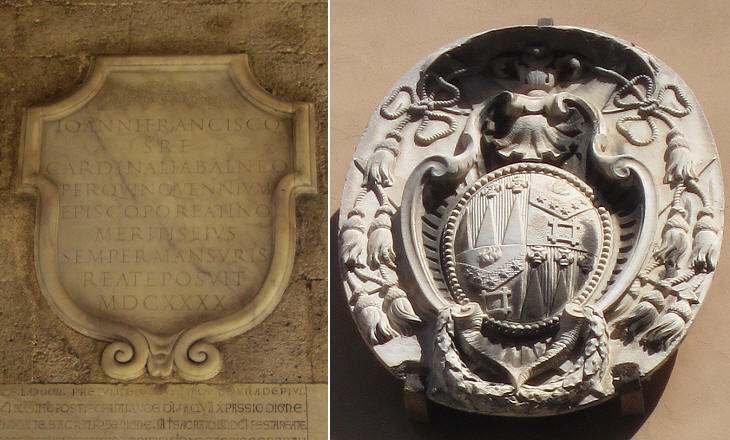
(left) Inscription celebrating Cardinal Giovanni Francesco Guidi di Bagno in the Cathedral, Bishop of Rieti in 1635-1639; (right)
coat of arms of Cardinal Ippolito Vincenti Mareri (1738-1811) in Palazzo del Comune. He was born in Rieti and he founded
charitable institutions in his town, but he was not its bishop
Rieti returned under the direct control of the Papal State in 1425. After that year it was rarely involved in political and military events. It was run by an governor appointed by the pope, usually not having the rank of cardinal. This meant that issues related to the town did not receive much attention from the central government.
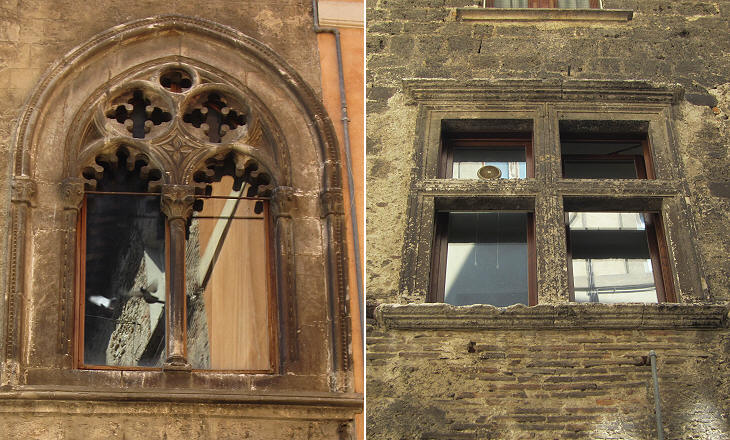
The earthquake which struck Rieti in 1898 led to a reconstruction which did not care too much about retaining the historical aspect of the town, exception made for the buildings which had some particular features such as the windows shown above. Latin cross windows were made popular in the second half of the XVth century when they were introduced in Rome at Palazzo Venezia and at Casa dei Cavalieri di Rodi.
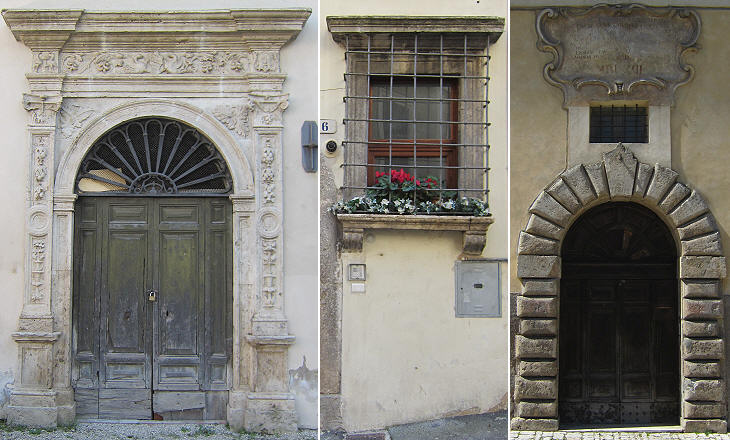
XVIth century memories: (left) Portal of Palazzo Colelli; (centre) window near Via Roma; (right) portal of Palazzo del Seminario
During the XVIth century Pope Paul III and Pope Clement VIII took steps to improve the emptying of the Velino River into the Nera, mainly because it caused floods at Terni, Narni and eventually at Rome. In 1787 other improvements were made and in 1896 the waterfalls started to be exploited to produce electricity.
Palazzo del Governo is the finest Renaissance palace of Rieti. It is the office of the Prefetto, the representative of the central government. It was acquired in 1589 by the Vincentini, a family of wealthy landowners, who added an elegant loggia to it. In 1923 Rieti and its territory were detached from Umbria and became part of Latium. In 1927 Rieti acquired the status of provincial capital, which meant that many government offices, schools and tribunals were located in the town.
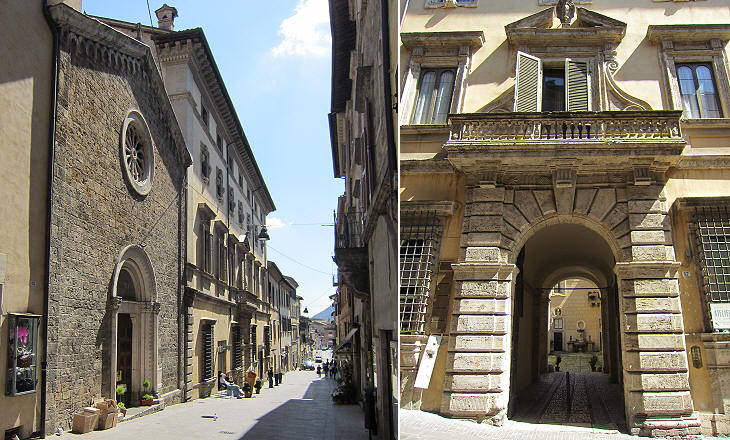
(left) S. Pietro and Palazzo Vecchiarelli in Via Roma, the street leading to the ancient Roman bridge; (right) portal of Palazzo Vecchiarelli
The Vecchiarelli were another family of rich landowners who in the second half of the XVIth built a palace in Rome, which is generally attributed to Bartolomeo Ammannati, a leading architect.
They then decided to build a similar palace in their hometown.
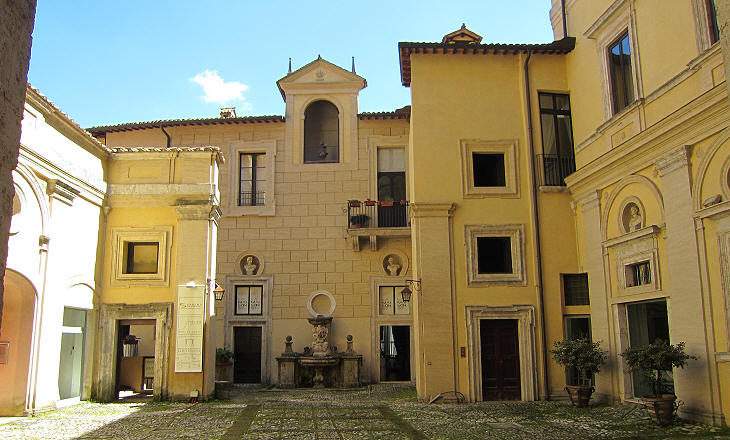
Palazzo Vecchiarelli: courtyard
The palace was built on the basis of plans drawn by Carlo Maderno, another leading architect, but its construction took a long time and the courtyard shows architectonic elements which became popular after the death of Maderno in 1629.
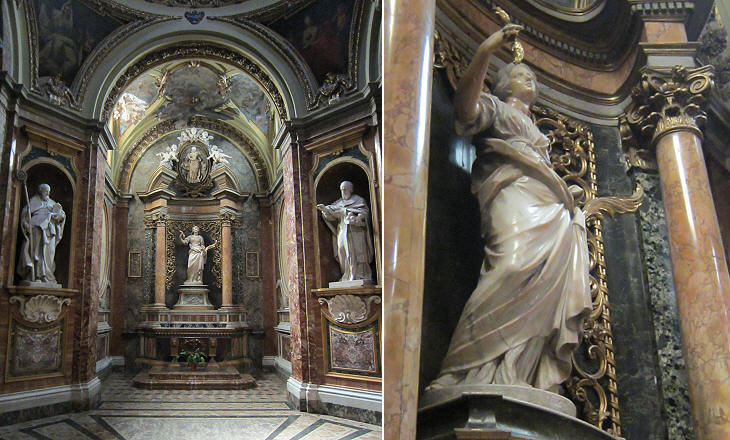
Cathedral: Chapel of St. Barbara, patron saint of Rieti
In 1639 the interior of the Cathedral was renovated in the style which was being developed in Rome by Gian Lorenzo Bernini. The renovation of the Cathedral was not completed until the end of the XVIIIth century and it was decorated by leading Roman artists. The image used as background for this page shows one of the new chapels. In 1651 Bernini was asked to assist in the design of a chapel dedicated to St. Barbara. He sent a plan of the chapel and a sketch of the statue of the saint. The latter was eventually executed by Giannantonio Mari, a sculptor of Bernini's inner circle. It is rare to see such a lavishly decorated chapel in a provincial town.
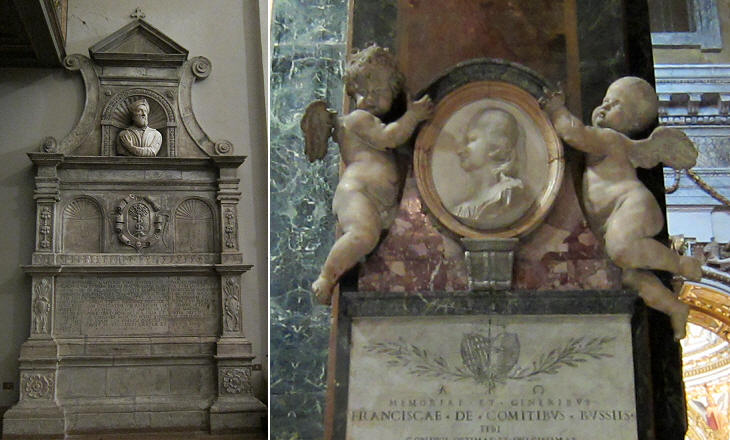
(left) Monument to Paolo Buonamici in S. Chiara (1566); (right) Monument to Countess Francesca Bussi in the Cathedral (1792)
The design of funerary monuments in the churches of Rieti reflected the prevailing patterns in Rome and some of them were probably executed by sculptors from Rome. Paolo Buonamici from Casperia was a "medico cum summa rerum naturalium scientia" (a doctor with in-depth scientific knowledge) and a benefactor.
Countess Francesca Bussi was the wife of Marquis Francesco Belloni, a wealthy banker. In the inscription her husband expressed his grief for her death, but he was known for having a mistress in Rome. The small funerary monument follows a pattern which was developed in the XVIIth century.
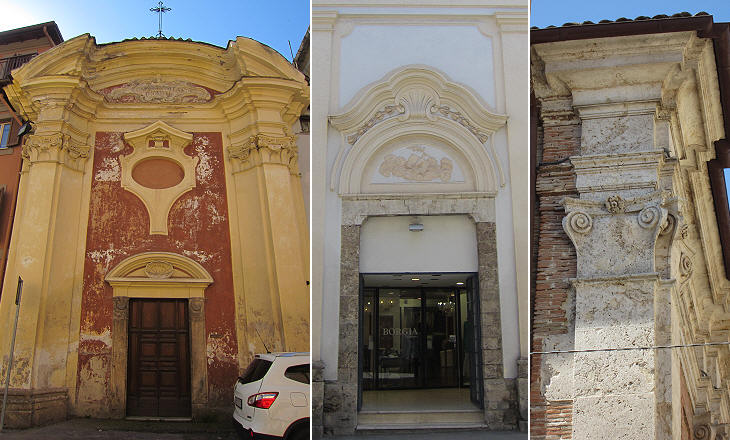
(left) S. Giuseppe; (centre) deconsecrated church in Via Cintia; (right) detail of S. Scolastica
In the XVIIIth century many small churches were built which were similar to the Roman ones. S. Giuseppe has the elaborate mouldings and stuccoes typical of "Roman Barocchetto".
S. Scolastica was designed by Carlo Fontana, the leading architect in Rome after the death of Bernini.
In the XVIIIth century several medieval town halls of provincial towns such as Nepi were given a modern fašade. At Rieti Palazzo Comunale was redesigned in 1748, by Filippo Brioni, an architect who worked at the completion of the Cathedral too. The building was slightly modified in the XXth century.
Return to Rieti - Roman and Medieval Monuments or to the Archaeological Museum of Rieti.

